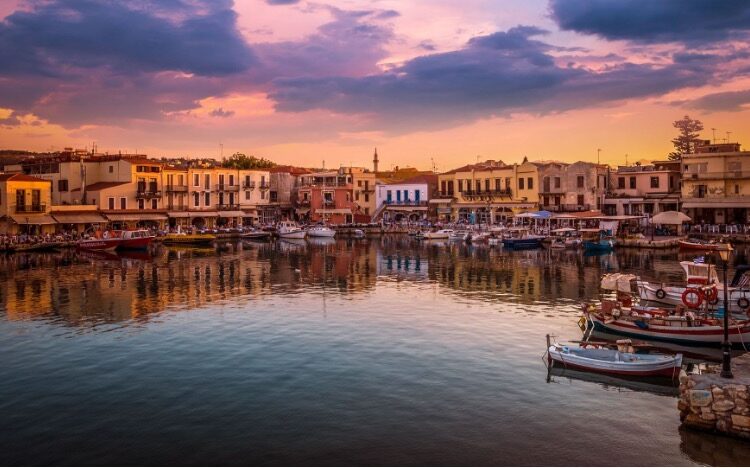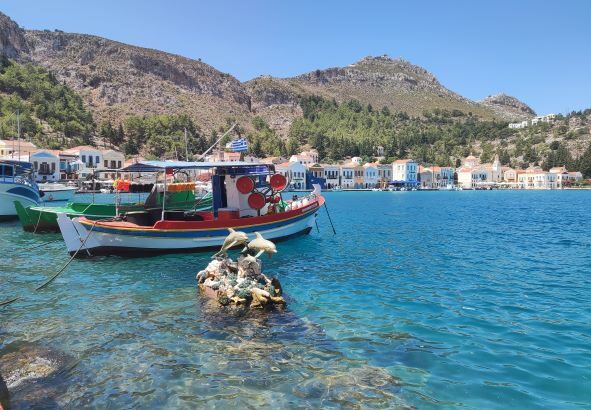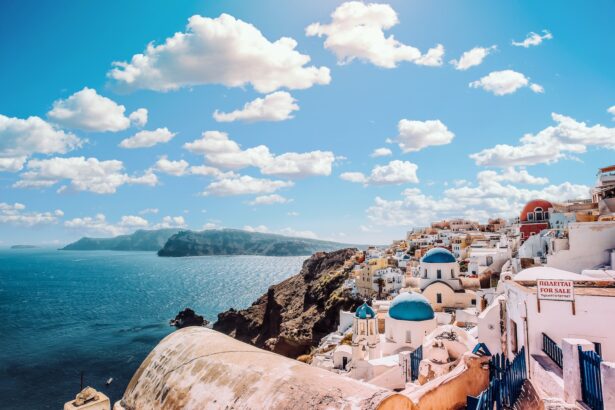Basic info
Rethymno is a prefecture situated between the Chania and Heraklion areas. It retains its historic beauty while being mostly undiscovered by foreign tourists. Rethymno (Greek: Ρέθυμνο) is alternatively spelled Rethimno, Rethymno, Réthymnon, and Rhithymnos, depending on the translation into Latin letters, as Greek pronunciation cannot always be accurately transliterated. The spellings are correct in all cases. To be fair, “Rethymno” is how most people refer to it on the island. As for pronunciation, this could be more or less: ɾeˌθɪmno pronounced: ré (like in red) – thee – mno.
The name comes from the Minoan era, when contemporary Rethymno flourished on the old Rhithymna and the neighboring Arsinoe. Rhithymna was a significant civilization center, having its own coinage with marine symbols (the best-known one includes two dolphins in a circle). The city is now the capital of the Rethymno regional unit or prefecture, which is the third most important in Crete, after Heraklion and Chania. It is located at the base of the Psiloritis mountain range, roughly midway up the island’s north coast. The town’s magnificent fortification on the seafront is clearly identifiable as you drive down the freeway.
Rethymno is a little town, where the weather is pleasant all year, the residents are kind, the atmosphere is relaxed, the food is delicious, and the costs are reasonable. For most visitors, Rethymno is a pleasant surprise. While Chania receives most of the focus, Rethymo’s lovely Old Town, with its Venetian stronghold and sheltered harbor, is a noteworthy attraction. The Old Town, which is a joy to explore on foot and is rich with Venetian homes and churches, many tiny Ottoman-era mosques, and the 16th-century citadel, has been marked by periods of Venetian and Ottoman control.
The timeless attractions and different landscapes of Rethymno, as well as the city architecture, museums, ancient sites, infinite sandy beaches, and getaways to adjacent towns, will provide you with a rich cultural but relaxing experience all year. Rethymno is a place of cultural pride as well as natural beauty.
The uninterrupted huge beach hotel strip spans from the east end of Rethymno, lapping up the coastline “villages,” and the Rethymno that allows you to experience the flavor of the Old Town with its blend of architecture and history, cultural influences, and styles.
Why work from Rethymno as a Digital Nomad
Citizens who can work from anywhere in the globe are often technology specialists, but as the epidemic spreads, corporations of many industries have begun to provide remote jobs. Digital nomads who relocate to Greece may benefit from a 50% tax cut for the first seven years thanks to legislation enacted by the Greek Parliament recently. Of course, you should research tax rules that apply to your specific case.
It is widely known that all Digital Nomads yearn for one thing: the ideal place to unwind after a long day of work. You do not need to change jobs to relocate. With more individuals going remote, today is a better time than ever to pursue your ideal life. It’s reasonable to assume that Crete’s hospitality and zest for life put it at the top of the list. Certain features of a city are essential for a Digital Nomad’s existence, and Crete offers them all and more.
Rethymno, the delightful small village, on the island of Crete, that floats in the middle of the Mediterranean, hardly need an introduction. The history is intriguing, the food is delectable, and the weather is pleasant throughout the year. Rethymno is endowed by nature with a mild temperature, plenty of sunlight, and a mix of beaches and mountains. In both day and night life, the cost of living is very reasonable. Although working / co-working facilities are scarce in the city and commercial districts, there plenty alternatives for working as a Digital Nomad. If you want to turn your room into a more work-friendly setting, all you must zdo is ‘ask.’ Nothing gets in the way of the Greek hosts.
There are several activities and lifestyles available, like gorging, mountain hikes, sea sports, oil and raki production, and so forth. The most crucial aspect, though, is the excellent connection — both to the WiFi and to the people!
Getting to Rethymno

By plane
Although Rethymno does not have its own airport, you will most likely fly into Chania or Heraklion. Take the bus from Chania International Airport to Chania’s main bus station, in the center of Chania town, then change buses to Rethymno. The bus stop in the airport is located outside the terminal building, and the trip to Chania will cost 2.30€, followed by 6.70€ from Chania to Rethymno. It takes roughly an hour to get there from Chania to Rethymno. Similarly, you’ll need to take a bus from Heraklion International Airport to the town center, then another bus to Rethymno. The bus to Heraklion costs 1.20€, while the bus to Rethymno costs 8.30€, for a total journey duration of roughly 90 minutes. Every hour, a bus departs from both Chania and Heraklion to Rethymno.
By ferry
Since there are no direct ferries to Rethymno, you must first travel to Heraklion or Chania. Those cities are easily accessible from Athens by ferry since there is daily connection with Piraeus port all year. During the summer, you may get to Heraklion Port from several of the Cyclades and Dodecanese islands, like Santorini, with which Heraklion has daily connections. Heraklion has weekly ferry connections to Mykonos, Paros, and Milos, as well as three weekly connections to Karpathos, Kassos, and Rhodes. You may go to Rethymno via taxi, KTEL bus, or vehicle once you arrive.
The port of Rethymno is periodically connected to Athens, Rafina, Andros, Ios, Milos, Mykonos, Naxos, Paros, Santorini (Thira), Tinos, depending on the time of year.
Important note: Ferry timetables might change from year to year. Ferry timetables for the summer season are usually issued in March by most ferry operators. Travel time by ferry is about 9 to 10 hours, and the journey is typically an overnight trip.
Getting around Rethymno
Walking or cycling is the ideal way to move through Rethymno, especially in and around the Old Town, due to its small size. The bus is an alternative if you want to travel further away. The primary bus stop is located west of the castle on the seaside road, and rates range from 1.40€ to 2.50€.
Public transportation
KTEL, is a Rethymno-based public transportation company that offers 12 bus routes with approximately 120 bus stops. Given the provincial character of the town, the road network and public transportation system is typically in good condition. From early morning until late at night, city buses serve Rethymno and the surrounding towns. Intercity buses link Rethymno to all of Crete’s prefectures, making travel convenient for both inhabitants and visitors. The KTEL “public” bus network, rovides most of the transit to the region’s towns, cultural sites, and beaches. The routes are served by KTEL buses, which are new buses with air conditioning, wi-fi (most of them), and are very easy to ride in. Here is the timetable and here you can find the pricelist.
Car rental
At Chania’s and Heraklion airport, major worldwide brands and local automobile rentals are offered, with regular rates ranging from 20€ to 80€ per day. The price of a car often declines as the number of days you rent it increase, and this is often depending on the time of your trip. Driving licenses from the US and other nations are both recognized. You can also find a car to hire in the center of Rethymno near the Old Town and the port.
Taxis
If you want to travel about the prefecture in comfort and elegance, you may take a taxi. When you arrive at the Chania or Heraklion airport or port, for example, you will notice many taxicabs waiting to transport you anywhere you want to go. In the capital of the prefecture of Rethymno, as well as the most famous tourist destinations, there are several taxis stops. There is also a radio-taxi service. The costs of most journeys to popular places are predetermined. Some examples of taxi rides: Rethymno to Bali takes around 30 minutes and costs 38€. The trip to Triopetra, which takes 40 minutes, costs 60€. Here you can find a pricelist and some useful information.
Bicycles
The Municipality of Rethymno received the Bike Friendly Destination Certificate. Rethymno is now officially part of a group of six Greek cities that use best practices in alternative transportation, have the infrastructure in place, and are taking steps to improve long-term mobility. The Municipality of Rethymno has the infrastructure that can support cycling tourism and is friendly for cycling routes both in the city and the inland, with more than 15 km of bicycle paths in the city and more than 100 km in the broader area.
The municipality cooperates with individuals who come to Rethymno and apply the bikesharing system. Anyone in the city can easily and at a very low cost find an electric or regular bike and be served for his transportation to the beach, for shopping or sightseeing. There is also the EasyBike system that everyone can use. Aimed towards anyone who travels regularly or seldom and wants a healthy, alternative, and cost-effective method of transportation without having to carry his own bicycle. Residents and tourists to the region can use the EasyBike system by issuing a specific electronic card (subscribers) or by using their credit card (occasional users). Permanent residents and frequent visitors can register as users by getting a special electronic card that grants them access to the system, whilst occasional users or guests can acquire access by issuing a specific access code with their credit card. The card may be used in rental stations, on a mobile phone, or through the Internet.
Digital Nomading specifics
Internet speed/mobile coverage
The WiFi network of the Municipality of Rethymno includes 85 access points with a total real speed available on the network that exceeds 1 Gbps. The Municipality of Rethymno currently covers the most areas near the Old Town, the port, and the beach. Here you can see the map with the free WiFi coverage.
If you want to use your own cell phone, laptop, or tablet to access the internet, bear in mind that 5G is not available in Rethymno. On the other hand, 4G service is available in most inhabited regions (of varying, but generally good quality). Cosmote (OTE), Vodafone, Forthnet, and Wind all provide short-term mobile internet services. Their special offers and pricing vary frequently, so it’s best to check their websites (all of which have English versions) to see what’s currently offered.
In order to have a realistic view of the actual network speeds of each provider, it is preferable to consult a third-party test platform, as the providers tend to “boost” the performance of their network. Here you can find the latest real speed-tests in Rethymno according to testmy.net.



Coworking places
Rethymno provides many coworking alternatives. If you prefer working from quiet cafès, you will love this city for sure. There is an abundance of lovely laptop friendly restaurants, bars, and cafès and almost all have excellent WiFi connection. There are simply too many to list them here, so it’s up to you to decide depending on your tastes. Despite Rethymno being really small, it still has one nice coworking space to offer.
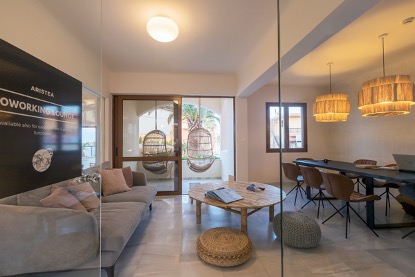
An extremely fresh and pleasant coworking space that provides an amazing bleisure (aka business and leisure) experience to our visitors, as well as the rest of the community. A perfect spot with a view of the pool to get some work done in quiet, share your expertise, socialize, or simply be. There is a large table with plenty of room to host a meeting or a workshop. There’s also a 50-inch screen and paper whiteboards. Move to the sofa and lounge chairs if you want to assume a more comfortable position. It’s not an office; it’s a living room with super-fast internet, coffee, and snacks. Find more info’s here.
Networking-coworking
Urban nomads may acquire a feel of the local scene through networking, while locals can receive a global perspective on what’s going on through networking. This is the most important feature since it promotes local engagement while also fostering a sense of belonging. Joining the Facebook group “Digital Nomads Rethymno – Crete” allows you to connect with other digital nomads from all over the globe, learn from them, and share your experiences. You may also join “Coliving – Coworking community in Rethymno” Facebook group, where you can find lots of information about the city and speak with local people.
Meet New People in Rethymno
Many visitors fall in love with Rethymno and wish to live there for the rest of their lives. There are so many individuals living an alternative lifestyle, close to nature, in a tiny but not repressive community. It’s easy to make friends and even easier to have a wonderful time every day because everyone is always open and friendly.
If you have a Greek friend, you already know how much they like partying and having a good time. This is especially true when they have visitors from different nations. If you go out with them, usually they will not let you pay for anything (and will consider it disrespectful if you do) and will make sure to show you around and take you to the nicest locations.
Where to stay
In Rethymno, there are several hotels, all-inclusive resorts, villas, and other places to stay. No matter what your budget is, you may locate any type of lodging. From exclusive boutique hotels in the Old Town, housed in magnificent Venetian architecture, to incredibly handy apartment rentals and inexpensive family hotels, there is something for everyone. When it comes to places to stay in Rethymno, everything is accessible. Unique beach resorts are also located in the city center, as well as beautiful villas on the southern shore. When you book in advance or outside of the city center, you’ll find great offers and lower rates.
If you’re wondering where to stay in Rethymno with a more flexible budget, mid-range hotels will be a perfect choice. There are fantastic hotels you can book in the Old Town of Rethymno as well in the modern city at quite convenient fees. You will be able to find some great hotels in a price range between 60€ to 150€ per night, both in the Old Town and in the city center. The apartments are ideal for a couple or a family with a little child looking for a place to stay. Both the Old Venetian Harbor and the contemporary town of Rethymno may be reached on foot. A small patio or balcony may be included as part of this kind of accommodation. Try booking a studio with two levels if you want a little extra room and privacy. If you want to save a few euros instead of eating out every day, apartments have a kitchen. You will be able to find some great apartments in a price range between 200€ to 400€ per month. Lots of houses and apartments are also available for long term rental.
In Rethymno’s Old Town, there are beautiful luxury boutique hotels that are known for their beauty and elegance. Old Venetian residences that have been renovated in the original architecture while still providing every conceivable amenity for a five-star stay. The cost of a night’s stay in any of these stunning locations starts at €160. However, don’t expect a hefty price tag to guarantee availability; these suites are in hot demand. So, if you’ve already made up your mind, don’t waste any time and book your stay as soon as you locate the perfect place.
Living expenses in Rethymno
Monthly living expenditures are estimated to be around 550€, divided as follows:
Accommodation: 250-350 € Food: 60-150 € Transportation: 40 € Entertainment: 100 €
The prices of several fundamental products that affect the cost of living (speculatively) are listed below:
Bus ticket: around 1 €
Bottle of water (0,5lt): 0,40-0,50 €
Bottle of water (1,5lt): 0,60-1,00 € (for a pack of six at a supermarket 1.50 -2.00€) Milk (1 lt): 1,00-1,50 €
Refreshments: 1,00-2,00 €
Coffee (at a cafeteria): 3,00-4,50 €
Beer (at a bar): 3,00-6,00 €
Cinema ticket: 5-7,50 €
Meal in cheap restaurant: around 8 €
Local cheese: around 10 €/kg
Greek souvlaki: 2,50-3,50 €
Learn Greek in Rethymno
You can get by in Rethymno without knowing Greek, but if you want to integrate, you’ll need to learn a few. In the first few weeks and months, you’ll pick up words and phrases quickly, but being proficient in Greek will take considerably longer. Most competent Greek speakers are foreigners who are married to, live with, or work with Greeks, implying that absolute immersion is the best approach to acquire the language. Many foreigners find it more difficult to acquire the language since they have little contact and interaction with locals, and the Greek friends they make at first are likely to be individuals who speak good English. A thorough understanding of Greek grammar is essential for learning the language, and there is also a new alphabet to master (although learning the Greek alphabet is not so difficult as it may first appear).
Free Greek Classes in Crete
Free Greek classes are available at various times throughout the year for EU residents and legal immigrants in towns in Rethymno, organised through “ΚΕΕ”, the Greek Centre for Adult Education.
Contact KEE in Rethymno for details and enrollment: Plateia Pigi – Arkadi Pigi Tel. +302831071454 Email: [email protected]
Greek Language Courses at the University of Crete
Throughout the year, the University of Crete provides Modern Greek language classes. The autumn and spring semester courses are primarily designed for new Erasmus students and
academic guests to the University. Greek language classes are also available (depending on availability) on the Rethymno campus for anybody interested in learning the language. Information and Contact Details: https://www.uoc.gr/intrel/en/researchers/language-courses Email: [email protected]
Mobility specifics
Car use was found to be the most common mode of transportation (60 %), with walking and biking accounting for just 20% and 5% of the modal share, respectively. Rethymno introduced initiatives focusing on accessibility, active mobility, and modifying mobility behavior through CIVITAS DESTINATIONS. There were actions supporting electric cars (EVs), boosting walking, cycling, road safety, and improving mobility services. Rethymno experienced a rise in sustainable commuting across a variety of demographics, including school communities, seniors, and individuals with disabilities. Rethymno is well-known for being an accessible city with infrastructure for individuals with disabilities. The objective is to improve the quality of life for everyone, whether they are residents or visitors, while avoiding segregation or exclusion. For elders or those traveling with a disability, Rethymno provides a variety of accessible vacations and leisure activities.
Useful information
Public infrastructure
The road network is in excellent shape and can take you anywhere. It is paved in most places, although you will most likely be driving on a gravel road in some rural beaches and mountainous places. You can travel the region in less than two hours on average if you drive cautiously during your journey.
Parking
Two parking areas, totaling 520 car parking spots and 60 motorcycle parking spaces, are located in the eastern and western parts of Rethymno’s port to serve the inhabitants. From 02:00 to 17:00 every day, 126 parking places in the eastern side of the port are free.
Water
Tap water is potable everywhere in the city. However, you may use a water filter because of the slightly increased content in salts and minerals.
Working hours
-Banks in Rethymno are open from 8 a.m. until 2.30 p.m. Credit cards such as Visa, MasterCard, Maestro, and others can be used to withdraw cash from cash machines (ATMs) placed outside banks and across cities.
-Public Offices: Monday – Friday 7:30 – 15:00
-Post Offices: Monday-Friday 7:30 – 14:00
-Shops are open on Monday and Wednesday: 9:00 – 15:00, Tuesday, Thursday, and Friday: 9:00 – 14:00 and 17:30 – 21:00, Saturday: 9:00 – 15:00. During the summer months shops have free working hours.
-Pharmacies are usually open from 08:00 to 14:00 on Monday and Wednesday. On Tuesday, Thursday, and Friday they are also open in the afternoon from 17:30 to 21:00. There are also emergency pharmacies which are open 24 hours and at weekends. You can find the lists of them on the doors of all pharmacies.
Internation call code
The international call code for Greece is +30. If you wish to make a call from abroad, you should call +30, followed by the telephone number. If you wish to call another country from Crete, dial 00 and then the code of the country and the telephone number.
Currency-exhange
In Crete, like in the rest of Greece, the euro € is used. Coins of 1, 2, 5, 10, 20 and 50 cents and of 1 and 2 euros circulate. The notes circulate in values of 5, 10, 20, 50, 100 and 200 euros. Before your trip, contact your bank to inform them about the use of your credit card and the withdrawal of money.
Emergency numbers
Emergency Hospitals: 166
Police: 100
Fire Brigade: 199
Emergency Intervention of the Port Authority: 108 Εuropean Emergency Number: 112
Covid-19 Info Agency: 1135
The European Emergency Number was created to serve the citizens on a 24-hour basis in case they need help, no matter in which country of the European Union they need it. The call is answered immediately by a specialized professional, with whom you can communicate in one of the basic European languages. The call from a fixed phone, a mobile phone, a telephone box, or a public telephone appliance is without charge. The European Emergency Number also operates in Greece and serves the visitors of our country. The number operates within the range of any mobile telephony network, even if your own network does not function in a specific area, provided there is coverage by another network.
There is also a Civil Protection Alert system that informs all residents in a specific area through mobile push notifications for natural disasters or other significant events, giving specific guidelines and directions.
Miscellaneous
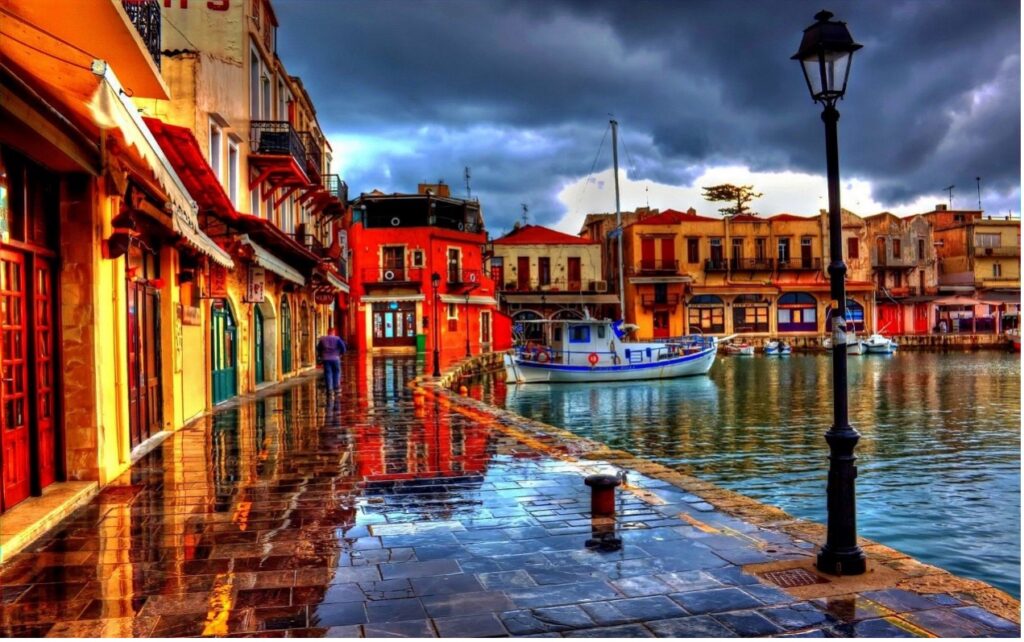
Rethymno all year round
When dressed in the colors of each season of the year, Rethymno transforms totally. With an average yearly temperature of 12-20°C and seven hours of sunshine each day, it is suitable for fall, winter, and spring activities such as walking, cycling, and horseback riding. Gorgeous attractive villages with architectural traits from different historical periods springing up in a green and unexpectedly beautiful natural setting, waiting for you to discover their past and listen to their enchantment. Traditional communities in good condition, breathtaking mountain scenery, canyons, safe natural walking pathways, innumerable caves to explore, and beautiful meadows with citrus trees and olive orchards, which have been the basis of the famed Cretan diet for generations. The Digital Nomad in Rethymno is exposed to an equally fascinating part of life on the island, as well as the many opportunities that Rethymno provides throughout the year. Rethymno organizes numerous cultural events that attract not only Rethymnians but also people from all over the island during Autumn and Christmas, such as the Renaissance Festival in October and the Rethymno Carnival in February, which is one of the greatest in the country. At the same time, the town’s high-quality cultural events, which are arranged or presented throughout the year, may please even the most discerning guest and provide lasting memories.
Weather
The climate of Rethymno is characterized as warm and moderate. Rethymno receives significantly more rainfall in the winter than in the summer. The hot season lasts for 3.3 months, from June 9 to September 19, with an average daily high temperature above 27°C. The hottest month of the year in Rethymno is July, with an average high of 30°C and low of 23°C. The cool season lasts for 3.8 months, from December 2 to March 26, with an average daily high temperature below 18°C. The coldest month of the year in Rethymno is February, with an average low of 10°C and high of 15°C.
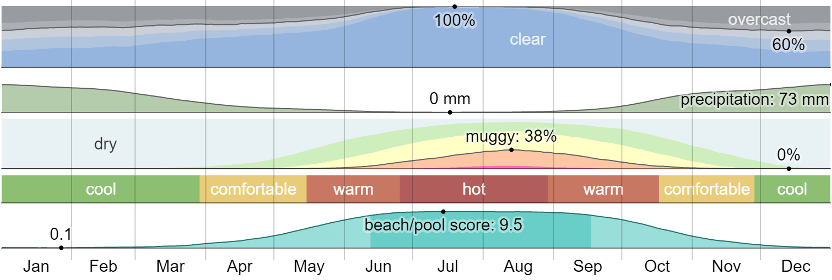
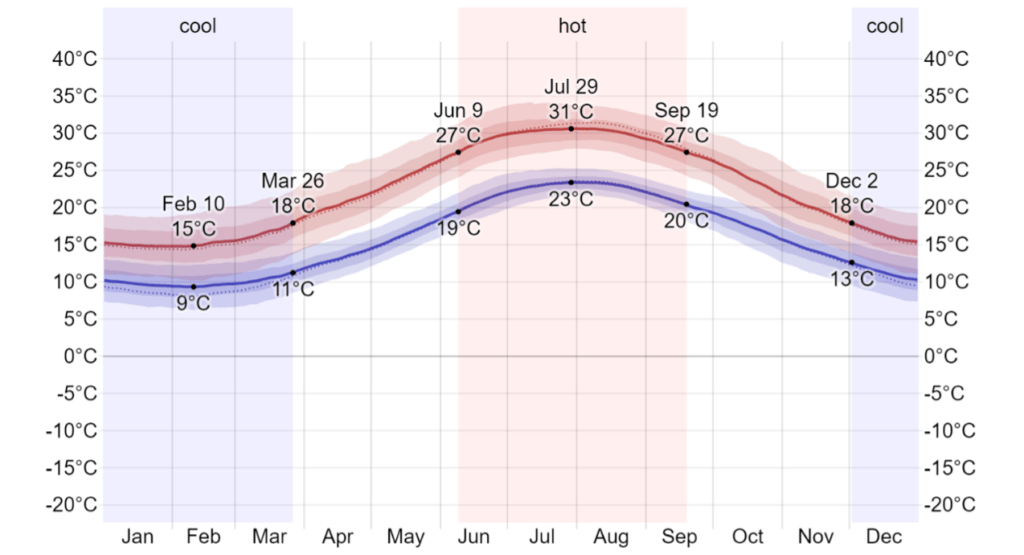
Sightseeing
The Old Town
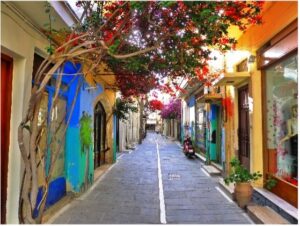
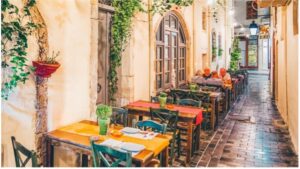
The Old Town of Rethymno is a jewel of traditional architecture, ideal for exploring walks in the narrow alleys, and at the same time offering its visitors the chance to enjoy all the Cretan flavors, as the area is full of small tavernas and shops.
Fortezza Castle
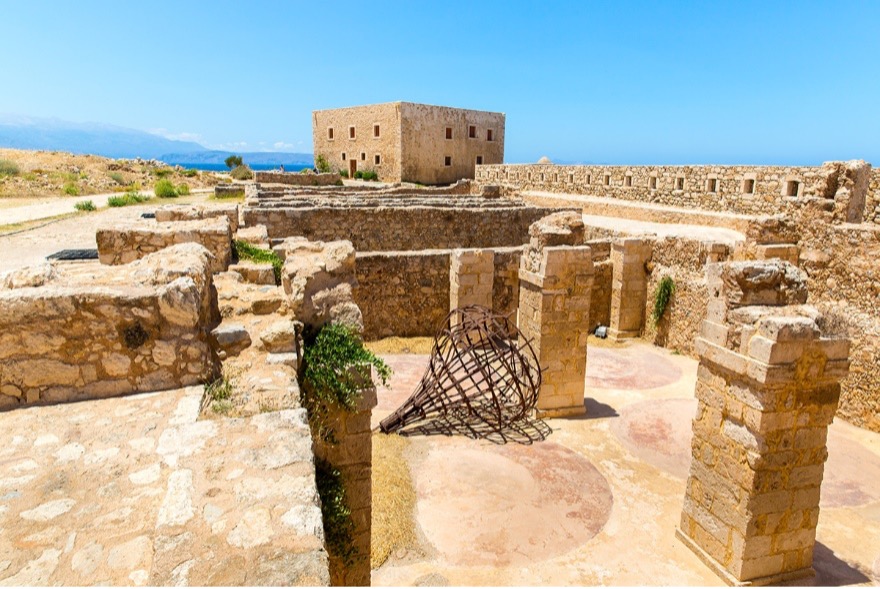
Fortezza is the citadel of the city, built in the 16th century by the Venetians, and is an adornment of the town. Every year especially in the summertime, it hosts events, exhibitions, and artistic performances, and from above, you can enjoy the open sea and the beautiful sunset.
Venetian port and the Lighthouse of Rethymno
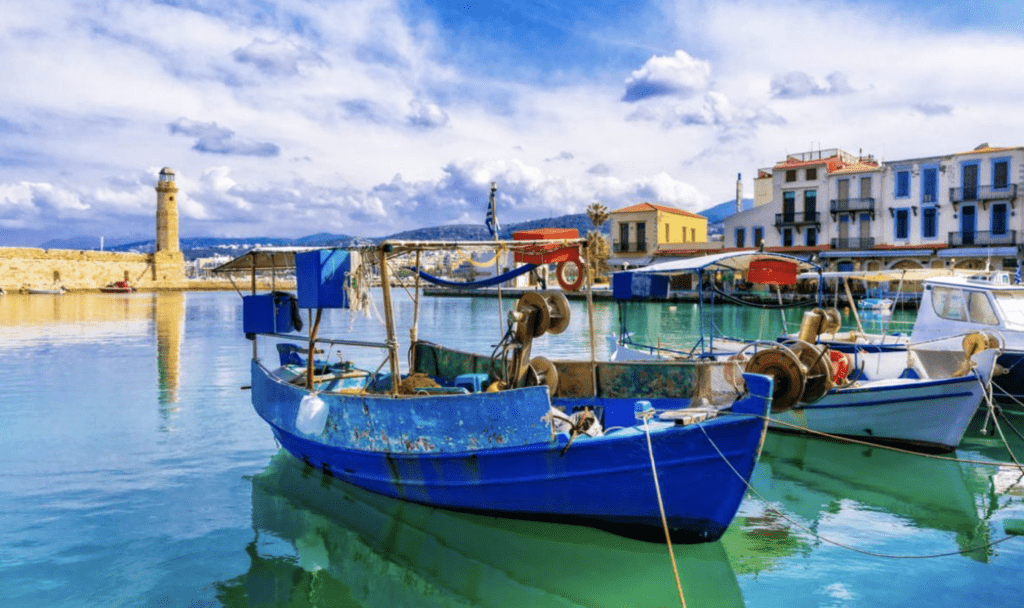
The Venetian port is the old port of the town and one of the most famous places, as long all the visitors have been taken photos of the point as a souvenir! There are many fish tavernas and café and is an ideal occasion for a walk, while the lighthouse is the trademark of the city.
Rimondi fountain
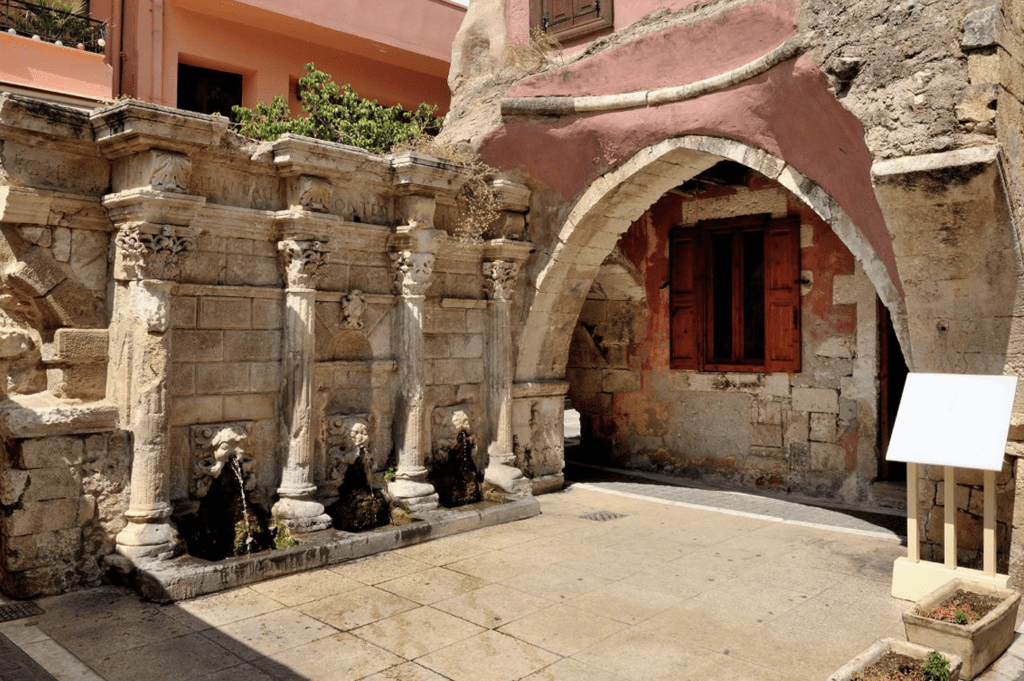
One of the most popular things to do is to stop by at the Rimondi fountain. Water runs continually from three springs that had the form of lion heads and in the past provided an important water source for the inhabitants of the Old Town.
Museums
This city is full of history! This is the reason that Rethymno has many museums such as the Archaeological Museum of Rethymno, the Museum of Contemporary Art of Crete, the Paleontological Museum of Rethymno, and the Historical and Folklore Museum of Rethymno.
Monasteries
Two of the major monasteries of Crete and amongst its most sought and visited, Arkadi and Preveli monastery are in close distance.
Ancient Eleftherna
The archaeological site of Eleftherna is placed at about 30 km to the south-east of Rethymno, on the northern foot of Psiloritis Mt. Eleftherna is one of the most important archaeological sites of Crete and provides important insight into the development of the settlement along the years. In fact, the inhabitation of the settlement apparently dates from the Prehistoric times and extends until the Early Christian era.
Gorges
You can explore the gorge of Kourtaliotiko (3-hour hike), which ends in the amazing Preveli beach. Patsos gorge is an easy walk. The gorge is green and there are refreshing water springs all around. Patsos is close to the Amari Valley and provides stunning view of the Psiloritis Mt.
Where to eat
Restaurants may be found in practically every village and organized beach in the prefecture. There are restaurants at the Venetian port and the streets of Rethymno Town, as well as nearby villages like as Anogia and Argiroupolis, and famous beach resorts such as Agia Galini, Panormos, Bali, Plakias, Adelianos Kampos, and others. The delicious local delicacies, including the famed ntakos salad, apaki smoked pork, herbs, pies, and more, are served in all Rethymno restaurants. Drink house-made wine or raki, a strong Cretan drink, with your dinner. At night, many taverns include live Cretan music, creating a great family scene.
Probably the most enchanting garden-restaurant in town, Avli is a home to fabulous cuisine and authentic Cretan hospitality. Don’t miss 7 Thalasses if you want to experience delicious, fresh seafood right by the sea. Also, Raki BaRaki if you’re looking for a more relaxed, informal atmosphere, authentic Cretan mezes, from mussels to sausages, from Cretan kalitsounia pastries to snails or rabbit stew, and much, much more. Veneto restaurant, located in the lovely Old Town of Rethymno, is considered as one of Crete’s best gastronomic attractions – and with good reason. Veneto has obtained certification from the Agronutritional Cooperation of Crete and the quality mark “Cretan Cuisine”. It has a fantastic ambience with
attractive design and excellent service. In Derlicatessen you can have some of the best gyros in Rethymno. Order a classic pita gyro (chicken or pork) or discover their grilled choices, like a whole chicken or lamb chops. All the portions are huge, but the prices are not. Othonas is worth checking out also. Do not leave without tasting the delicious vegetable salads, gyros, and octopus.
Exploring the taverns in the villages surrounded by the Cretan mountains and taking in the island’s natural landscapes is also a fascinating option. These taverns are not far from the town, yet they provide the unique experience of dining while being surrounded by the warm sea wind of Cretan nights or the tranquil burble of waterfalls. If you decide to go for a hike in the gorge of Agios Antonios (also known as Patsos gorge), then you must stop at Drymos tavern for a real Cretan meal. Goules is one of the top-rated restaurants in the Rethymno region (Goulediana village) and lives up to its impeccable reputation. The tavern presents a selection of old-time recipes with traditional Cretan traits, including plenty of herbs and tasty spices from the surrounding countryside. Athivoles is located in Argiroupolis and it is found in a beautiful setting overlooking hills and valleys. There are two dining areas, one indoor and an open-air right next to the waterfall, with tables just under the shade of tall trees. The cuisine is traditional Cretan. The menu includes cold and hot starters, grilled meat, fish and seafood dishes, salads, all homemade and with local products. The fish tavern Akrogiali is in the central port of Bali at Rethymno and is the ideal choice for those who want to enjoy exquisite seafood, with quality materials and attractive prices. In a beautiful and friendly place by the sea you can enjoy from noon until late evening local dishes, fresh salads and appetizers that will please your appetite.
Nightlife
The Old Town of Rethymno has few mysteries to reveal at night. The businesses close at 10 p.m., and the crowd gradually walks in. So don’t rush back to your hotel and extend your stay. At traditional tavernas, dine on delectable Cretan cuisine while listening to live music. You will not be disappointed if you get a jazz piano or folk Greek musical instruments. Otherwise, look for hidden bars in the gardens of houses or ancient buildings and sample some of the trademark drinks made with top-quality local ingredients. If nothing of these options appeals to you, simply stroll the streets and rediscover the small passageways beneath the stars. Don’t miss the Rimondi Fountain, which is lighted wonderfully in the nights.
If you want a more active nightlife, head to one of Rethymno’s greatest nightclubs. Cafes that are quiet during the day become vibrant nightclubs with live Greek and international music. It might be a live DJ, live musicians, or simply a fantastic night-time playlist. A little dancing area is available at several of the establishments.
Rethymno is one of the best spots to go for a memorable night out with friends while visiting Crete. In Rethymno Old Town, there are some of the nicest locations to hang out for residents and visitors alike. Stylish and lively, Living Room is always busy and ready to offer delicious seasonal cocktails. Fraules is one of the most popular places among Rethymno youth and students. In the evening, it can become really crowded, but this is what it makes so great. After 10 pm, Lux Cafe turns into a nightclub with a DJ playing great music. Enjoy your drink admiring the iconic Rimondi Fountain in the heart of Rethymno’s Old Town at Cul de Sac. A top nightclub and bar in Rethymno, Metropolis Society Bar can be found in the Old Venetian Harbor. Great parties are thrown here every night all year round. Fortezza Lighthouse Bar is where nightlife in Rethymno begins! There, you will find an outstanding dance floor and some of the best DJs coming from all over Greece.
Best cafes
Coffee is an unavoidable element of life in Greece. You’ll be hard pressed to find a Greek who does not enjoy coffee. People in this country start their days with coffee, live with coffee, adore coffee, and may even sleep with a cup of coffee! Locals can often be seen working, conversing, doing business, or even driving while holding a coffee cup.
In Greece, there are different varieties of coffee. The first is Ellinikós, a traditional Greek coffee that is like Turkish coffee (don’t mention this to Greeks!). Freddo espresso, or iced coffee, is the next favourite. When espresso coffee is blended with ice, it is known as freddo espresso. There’s also freddo cappuccino, which is made by combining espresso with ice and milk. Another type of cold coffee is frappe. Frappe is made in an interesting way, and it was invented here in Greece. This is a refreshing and really strong coffee drink. Another kind of coffee you can have, which is not very popular among the locals, is filtered coffee. It is also known as French coffee or American coffee.
You can find a cafe in almost every corner. Some of the best places for coffee in Rethymno are: Bankery, Barrio the Neighborhood Café, Meli Melo, Cul de Sac, Nuvel, Arokaria Café, Bee Coffeecomb and many more.
Festival and events
Rethymno Carnival
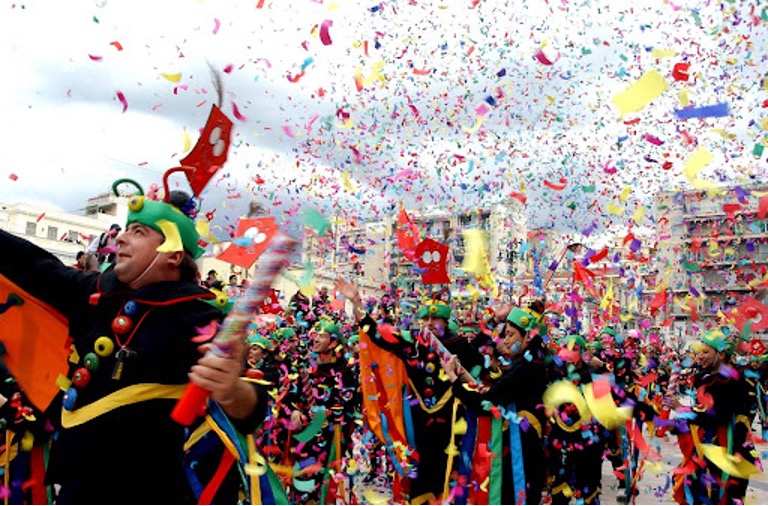
The second largest carnival in Greece, with the participation of the majority of the city’s residents, but also thousands of visitors all over the country, takes place in Rethymno every year with great success.
Renaissance Festival

The Rennaissance Festival takes place from late August to early September in various venues of Rethymno Town. The events include theatre performances of Medieval plays, concerts of Medieval age and exhibitions of baroque art.
November 8th
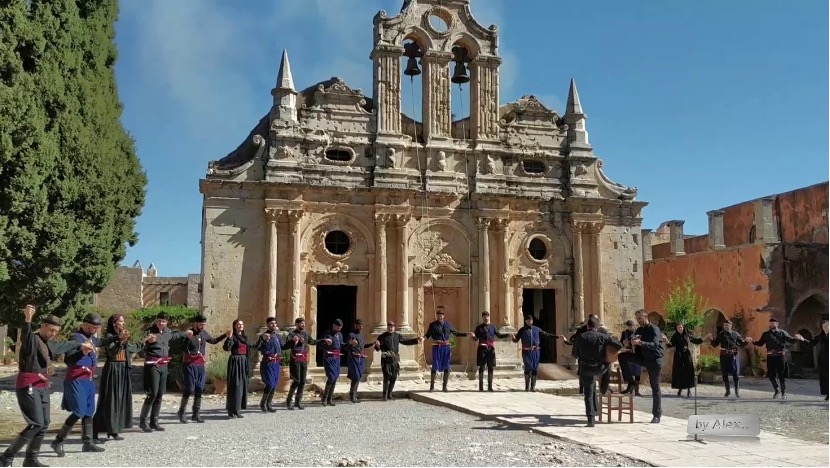
On the 8th of November, the locals commemorate the Arkadi Holocaust. A religious ceremony is held in the monastery of Arkadi, where the Cretan fighters exploded themselves in 1866 to
avoid surrendering to the Ottomans. The locals bring flowers to the monastery to honor the dead.
Beaches
At the southern coasts of Rethymno, there are lots of deserted bays and beautiful beaches, whilst the north coast is home to the more cosmopolitan beaches.

The crystal clean seas of Rethymno’s southern coasts are well-known. There are unusual sceneries there, such as the Agios Paulos dunes, which have golden fine sand and a peculiar energy atmosphere. The interesting Triopetra opens next to the dunes, one of Crete’s most beautiful beaches with unique huge boulders on one side. There’s also Preveli Beach, which is in the Kourtalioti River’s estuary and features stunning palm trees and natural baths on the main beach, as well as other, lesser known but equally beautiful beaches like Ligres. In the area of Plakias there are numerous small beaches, with Ammoudi and Damnoni among them.
The beaches in the northern coast of the county, on the other hand, are the most well-known, with most of them having been given the Blue Flag. The beaches of Rethymno and Episkopi are preferred by those who seek to avoid congested areas. Geropotamos is home to beautiful tiny bays with crystal blue seas.
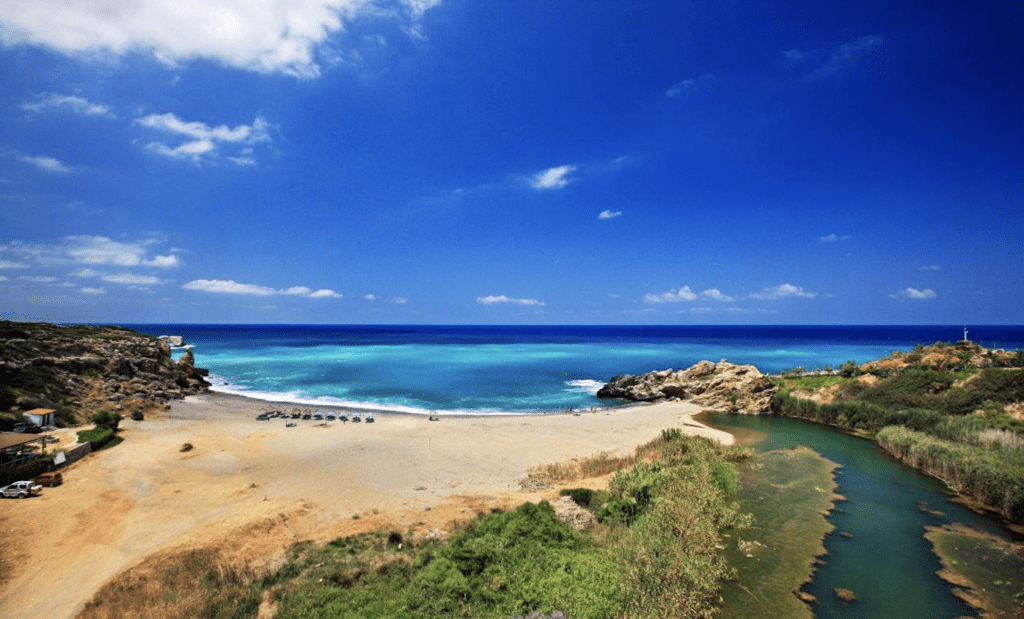
All Rethymno county’s beaches await your arrival as an amazing summer vacation, including some hidden gems such as the beautiful bay of Agia Fotia.
Villages
There are historical villages all around Crete. In Rethymno prefecture particularly, there are some of the most interesting villages to explore. In practically every village in this diversified section of the island, you can discover cattle grazing next to olive trees and neglected carob trees, confirming the island’s reputation as a farming zone. Anogeia has a long history, a rich cultural legacy, and a well-preserved weaving culture. The legendary Ideon Andron is where God Zeus was born, according to ancient Greek mythology. The Potamianos Wax Museum in Zoniana houses wax figurines of Eleftherios Venizelos, Kazantzakis, and reconstructions of historical events in Crete, among other things. The province of Amari contains attractive settlements like as Fourfouras, Thronos, and others that are lost in the valley’s natural richness. Finally, the region’s small ports, including Agia Galini, Panormo, Bali, and Plakias, are evocative and lively all year.
Another view of Crete may be found on the journey down to the prefecture’s central districts. You can visit equally beautiful villages such as Atsipopoulo, a Venetian settlement with an oak tree as a symbol, or Kalonichti, the birthplace of Nikiforos Fokas Byzantine emperor, or see the finish line of the Nikiforeios Road Marathon and then visit cattle-farming villages with caves full of legends and fairytales, such as Koumous and Saitoures, or the Roustika village. After the trek, stop in at one of Argyroupoli’s modest taverns to sample Cretan food and native raki. Remember to pay a visit to Maroulas and Margarites. Because of the nature of its distinctive architecture, Maroulas has been designated as a historical hamlet under special state protection, whereas Margarites is one of the two major pottery hubs on Crete. Whether you’re at the base of Psiloritis or near the seaside, don’t miss out on the pleasure of visiting the neighboring communities.

